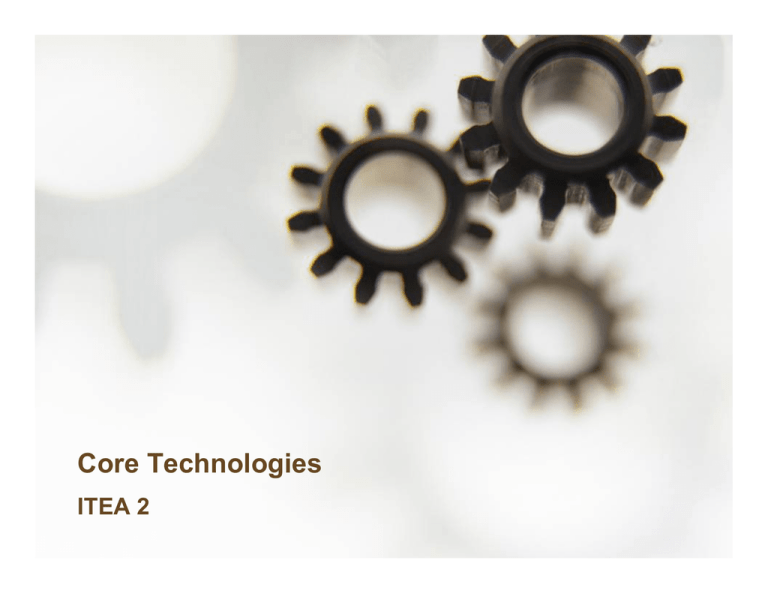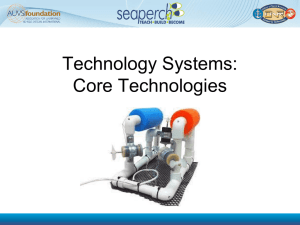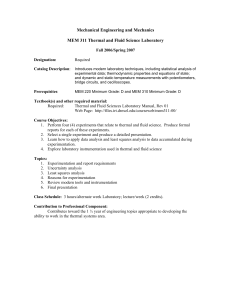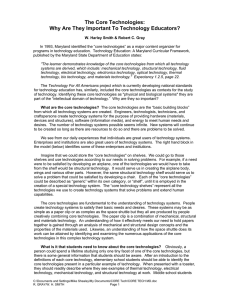Core Technologies - eLearning Solutions
advertisement

Core Technologies ITEA 2 Core Technologies The Core Technologies are considered to be the "basic building blocks" from which all technology systems are created. They include: (a) mechanical technology (b) electrical technology (c) electronic technology (d) structural technology (e) fluid technology (f) optical technology (g) thermal technology (h) biotechnology (i) materials technology Core Technologies (a) (b) (c) (d) (e) (f) (g) Instruction on the Core Technologies will provide you with an understanding of: common components; basic systems design; simple controls; system performance evaluation; science concepts applied; mathematics applications to measure, analyze, describe and predict; and safety practices for interacting with technology systems Core Technologies Produce Technology Systems Derivation and Application of Technology Systems TECHNOLOGY CAREER TEAMS Including: Engineers Technologists Technicians Craftsperson's COMBINE THE CORE TECHNOLOGIES TO PRODUCE TECHNOLOGY SYSTEMS Including: Mechanical Structural Fluid Electrical Electronics Optical Thermal Bio Materials Such as: Cars Telephone Systems Water Filters Highways Telescopes Drill Presses Exercise Equipment CD Players X-Ray Machines Computers Microwave Ovens Lawnmowers Furnaces Refrigerators THAT SUPPORT HUMAN ENTERPRISES & INSTITUTIONS Such as: Manufacturing Construction Transportation Communication Health & Medicine Agriculture Energy Recreation Finance Commerce Law Enforcement Public Safety Military Education Hospitality Government Personal Services Family & Household CORE TECHNOLOGY Mechanical Description The technology of putting mechanical parts together to produce, control and transmit motion. Applications Gear systems in a car transmission, brakes on a bicycle, agitator on a washing machine, latch set on a door. CORE TECHNOLOGY Electrical Description The technology of producing, storing, controlling, transmitting and getting work from electrical energy. Applications Power plant generator, flashlight battery, light switch, electric motor in a can opener, door bell, electric heater, hair dryer. CORE TECHNOLOGY Electronic Description The technology of using small amounts of electricity for controlling; detecting; and information collecting, storing, retrieving, processing and communicating. Applications Thermostat for controlling temperature, a metal detector, video tape recorder, computer, pocket calculator, telephone, radio and television. CORE TECHNOLOGY Structural Description The technology of putting parts and materials together to create supports, containers, shelters, connectors and functional shapes. Applications Legs of a chair, city water tower, swimming pool, buildings, storm sewer, airplane wing, satellite antenna dish. CORE TECHNOLOGY Fluid Description The technology of using fluid, either gaseous (pneumatics) or liquid (hydraulic) to apply force or to transport. Applications Air brakes on a truck, tires on a car, airfoils on an airplane, warm air heating ducts and fan in a building, hydraulic jack, plumbing in a school, gasoline pump. CORE TECHNOLOGY Optical Description The technology of producing light; controlling light, using light for information collection, processing, storage, retrieval and communication; and using light to do work. Applications Light bulb, LED (Light Emitting Diode), lenses to magnify and reduce, laser speed detector, laser compact disk, fiber optic telephone communication, laser cutting tools, laser surgery instruments. CORE TECHNOLOGY Thermal Description The technology of producing, storing, controlling, transmitting, and getting work from heat energy. Applications Furnace, hot water heater, toaster, insulation, heat exchanger (radiator, condenser), refrigerator, jet engine. CORE TECHNOLOGY Biotechnology Description The technology of using, adapting and altering organisms and biological processes for a desired outcome. Applications Stain “eating” enzymes in detergent, bacteria “leaching” of metals from ore, altering plant genes to produce better crops. CORE TECHNOLOGY Materials Description The technology of producing, altering, and combining materials. Applications Producing paper from wood, producing aluminum from ore, drilling holes in wood, annealing to soften metal, casting ceramic, welding metal, laminating wood. COMPLEXITY OF TECHNOLOGY SYSTEM Complicated Simple Small Size of Technology Systems Large A technology system may be very simple or very complex. It may be very small or very large. PENCIL SCISSORS MICROSCOPE COMPUTER FIRE ENGINE SPACE SHUTTLE NUCLEAR POWER PLANT Core Technologies Summary • • • • The Core Technologies are considered to be the "basic building blocks" from which all technology systems are created There are nine Core Technologies: (a) mechanical technology, (b) electrical technology, (c) electronic technology, (d) structural technology, (e) fluid technology, (f) optical technology, (g) thermal technology, (h) biotechnology, and (i) materials technology Technology systems can be small or large, simple or complex The Core Technologies are the bridge between science concepts and real-world technology. They provide numerous opportunities to describe, analyze, and predict physical phenomena using mathematics




